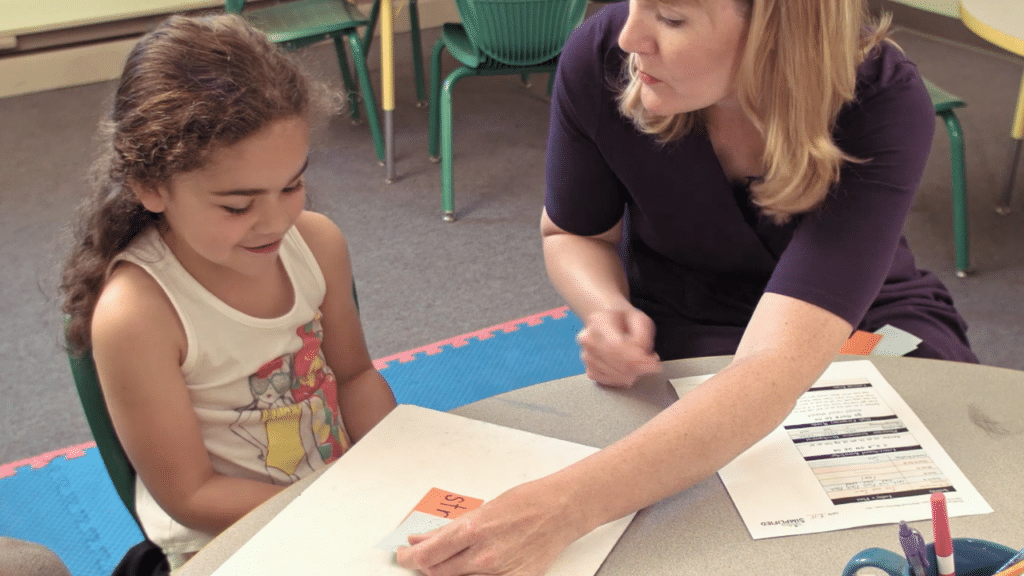
Maria is a beautiful, endearing child with carefully plaited braids and bows that match her skirt. Like millions of other children over the years, she enters Kindergarten, expectant, hoping to learn to read.
But will she? Easily?
Or,
Will she struggle?
Frankly, the US national odds are against Maria learning to read easily and well. (See NAEP.)
Today, however, our heroine begins a journey that neutralizes the odds. Her teacher enters the classroom armed with a vital weapon: the Blend As You Read strategy. This post will explain how and when to use this essential strategy.
Simple to use.
Simple to teach.
But rarely executed.
The Speed It Up Approach to Decoding
Most Kindergarten children like Maria will be in classrooms today where their teachers will ask them to try to read or decode an unfamiliar word. The teacher may even explicitly guide these children in the process of how to decode an unfamiliar word. It usually goes something like this:
Teacher: I’m going to teach you how to read a word! Say each of these sounds with me:
Teacher and Class: /c/…../a/…./t/.
Teacher: Yes! Now put them together. What word?
Class (some of it): Cat!
This is Implicit Instruction masquerading as Explicit Instruction. Often, the curriculum may prompt a teacher to help a student struggling with this approach to, “Speed it up” (not the name given to the direction, but it’s the approach). Thus,
/c//a//t/. Try it faster.
I’ve even seen the Speed It Up Approach to Decoding set to music a lá Sesame Street.
Who remembers this ditty?
….Uh oh, now it’s stuck in my head….
Unfortunately, the Speed It Up Approach to Decoding does NOT teach a child to read. No matter how cute the Sesame Street song is. 🙁 If it works for a child, she could probably already have read without it. But if it doesn’t work, then what’s a teacher to do?
The Blend As You Read Approach to Word Reading
If a beginning or struggling reader you are working with doesn’t intuitively know what is meant by “Put the sounds together,” or “Blend the sounds,” or the ubiquitous, “Sound it out,” then try the Blend As You Read approach.
Rather than saying each sound separately until the end of the word is reached, blend sounds cumulatively, continuously, or “successively” to read the word, as Isabel Beck puts it in Making Sense of Phonics: The Hows and Whys.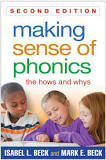
Successively add one sound after another instead of waiting till all the sounds in the word have been segmented or spoken. Hide the 3rd or 4th sounds in the word with a small card or your finger while the first 2 sounds are blended.

Model for the child how to put the first two sounds of a word together, i.e.,
/ssssa–/.
Have him copy you:
/ssssa–/.
Then have him add the 3rd sound in the word,
/sssa—t/.
What’s the word?
Sat!
Yeah!
The Blend As You Read approach works for 2 reasons:
- First, it reduces the burden on the child’s short-term memory. Remembering a string of isolated phonemes
(i.e., /s/ /t/ /r/ /ee/ /t/ )
is a lot harder unless you hear or see the phonemes as part of a meaningful word.
You try it!
Can you say these sounds once, look away, and then recall all of them? Easily?
m r q i u v a
You may have to strain your brain (your short-term memory) a tad to recall these, even though you are an adult.
Why?
Because they were random letter strings, not ordered that way in written language. The disorder of the letter string prevented your ability to blend the sounds together to make a word at the end of “reading” them. Just relying on short-term memory alone to attack a completely unfamiliar word is hard, especially for children with weaker auditory memories (one group of people who may particularly struggle with learning to read).
- Second, when good readers read, they begin by putting sounds or chunks of sounds together as they go. We can, thusly, offer this same strategy to our budding readers. When we attack an unfamiliar word, such as
polyphiloprogenitive
we say the beginning sounds or chunks of sounds and then successively continue adding sounds. [Even an 800 Verbal SAT student would not likely say
/p/ /o/ /l/ /ee//f/ /ie/ /l/ /oa/ /p/ /r/ /oa/ /j/ /e/ /n//i//t//i//v/
and remember the beginning sounds to attempt a word. Rather, the good reader builds or blends the sounds together As She Reads.]
In the context of a sentence, many children can deduce a word after simply putting the first two sound together to hear a word.
Try it:
The leaf floated across the ri_____.
Did you deduce “river?”
The context and the first 2 sounds combined to help you know that the word was likely “river.”
This is exactly the strategy that we want developing readers to employ–
Sound-Based Decoding, Coupled with Meaning-Making Comprehension.
When a young reader waits till the end of a word to try to put the sounds together, she short-circuits her ability to both sound-based decode and rely on meaning-making.
Our young Maria from the intro can learn—early on, with smart instruction—how to integrate 2 complex cognitive tasks simultaneously. In one region of her brain she can Blend As She Reads (sound-based decoding) while another region of her brain is searching for a meaningful word that fits the context of the sentence.
This flexible integration of 2 different word-getting processes is a beautiful, amazing accomplishment of the human mind. Some children deduce how to do both processes.
Many do not.
When to Use Blend As You Read
Never fear.
Pack your teacher’s tool belt with the Blend As You Read strategy and teach it every time you see a child struggle with a word or when the child says each sound separately and waits till the end of the word to try to decode it.
Here are our 2 favorite usages of the Blend As You Read approach:
- Teach Blend As You Read during the simple activity Read It. This is an activity that we use with developing readers as often as we brush our teeth. Here's a quick example of Read It in action:
Write a short word on a board or paper and ask the child to try to read it. If she uses a segment, segment, segment, word approach, then teach her to Blend As You Read. Or, if she gets stuck or mis-reads the word, teach her to Blend As You Read.
Recall that this means we hide the back-end of the word and ask the child to blend the first 2 sounds of the word. Elongate and stretch out the sounds and have her copy you. Then uncover each successive sound and ask her to add it to the word.
Read It often culminates with the student writing the word again—either with the word still visible or not, depending on her level of development. Importantly, as she writes each sound, she says each sound:
/m/ /a/ /p/
Not. The. Letter. Names.
Letter names are verboten!!
“What?!?” I hear you saying.
Letter names interfere with the sound-based decoding approach that a beginner needs to learn as she establishes her word identification foundation. (An upcoming post will dive deep into this issue of letter names vs. letter sounds.)
- Blending As You Read could also be reinforced when a child is doing any type of oral reading. As the teacher guides her and listens to her reading, she offers this effective feedback when a child stumbles with a word.
[We hope you are finding time every day to listen to every child read aloud—at least briefly. Those readers in the bottom half of the class should especially be targeted for this daily reading support.]
Readers grow with reading practice. Primarily accurate reading practice.
So, an adult or advanced reader is needed to guide the student when she trips on a word.
Aside: the text should be challenging enough that some mistakes are made, otherwise the child isn’t really learning much about decoding. The mistakes with effective correction are where 70% of the learning takes place.
(Are you wondering about a citation for the 70%? Um, it’s just a made up number. Ha! We hope it helps your remember the importance of the learning cycle of errors, feedback, and accuracy; repeat. Shy away from student errors and you shy away from rapid progress.)
2 Lessons About Phonemic Difficulty Before You Begin Teaching BAYR (Blending As You Read)
-
Match readers with relevant word types.
Ever heard a pre-school child say, “sgugetti” for “spaghetti?” She is still developing her ability to perceive and to articulate the more challenging phonemic (individual sounds) aspects of our language.
So, “cake” may not cause a youngster much trouble. But, “spray” may sound like “play.”
Similarly, a young reader will have an easier time with words that do not have multiple adjacent consonants, such as “spray.”
Teachers label different types of word difficulties with CVC, CCVC, CVCC, etc. to describe this level of challenge. Need help breaking the code? In order of phonemic difficulty, from easiest to most challenging:
CVC = Consonant-Vowel-Consonant words = cat, map, sit
CVCC = Consonant-Vowel-Consonant-Consonant words = fast, lamp, send
CCVC = Consonant-Consonant-Vowel-Consonant words = stop, frog, plan
CCVCC = Consonant- Consonant-Vowel-Consonant words = crest, brand, stump
CCCVC = Consonant-Consonant- Consonant-Vowel-Consonant words = strap, split
MS = Multi-Syllable Words = apple, fluffy, silver (with 2-syllable words being easier than 3 and 3-syllable words being easier than 4)
If this overwhelms, perhaps this visual which shrinks the concept to something more manageable:
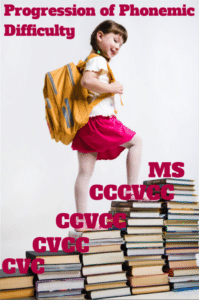
Why this lesson now?
A teacher’s word choices while she teaches Blending As You Read may make the difference between a child’s success or failure.
The difference between dyslexia endured and dyslexia conquered.
Consider where your student is on the above Progression of Phonemic Difficulty.
Can she read or blend the sounds in a CVC word, such as “nap,” without your help? If no, then stop right here and offer CVC words (i.e. “sat,” “map,” “mop,” “hid,” “hug”) during Read It and guided reading so she can learn how to Blend As You Read with the optimal phonemic challenge.
However, if she can already tackle CVC words, then take a step up the progression and consider if she can read or blend the sounds in a CVCC word such as “fast.” If yes, continue up the steps until you find a type of word challenge that your student is not yet prepared for and stop there. If she’s not able to blend CVCC or CCVC words, then stop right here and focus on words like that for Read It and guided reading.
In sum, match the level phonemic difficulty in the words you choose to instruct with to the child’s current ability level. Keep expecting to increase the challenge though. Don’t camp out at the CVC level for 4 weeks! Few elementary-age kids need that much time to learn how to blend 3-sound words.
-
Choose continuant consonants for beginning readers.
All consonants are not created equal. Some consonants will usher your struggling reader into quick learning of the Blend As You Read method while others will block them. Can you guess which of the following words would be best to use when you begin teaching Blend As You Read?
sat cat
Hmmm…Both are concrete concepts. Both would be well known to most young learners. Both include the short “a” sound, a common intro-level letter-sound.
What’s the significant difference?
Try to stretch how the sounds as long as you can. Or, try to sing them. Where are the points in the words where you can stretch for the longest? The short “a” can be sung or hum for a long time, right? How about the /s/ sound vs. the /c/ sound?
One can be stretched out, sung, or hummed.
One can’t.
The difference is that one word begins with a Continuant Consonant (/ssssss/) and one word begins with a Stop Consonant (/k/). After the “c” in “cat, your voice has to stop—you can’t elongate, stretch, sing or hum a /k/ sound. If you are, you are actually humming or stretching out an /u/ sound that’s not truly part of the /k/ sound itself. You may not have to learn those Continuant/Stop Consonant labels, but you should know which consonants are easier for beginning readers to blend and which are harder.
When a word begins with a Continuant Consonant, it’s easier for a child to blend.
What does this mean for instruction?
When planning a beginner’s lesson, select words that begin with Continuant Consonants (s, m, f, n, v, r, l, z), or those you can stretch or elongate, such as
sat mop fit sun mat nap vet run sit lip zip
And avoid words that begin with Stop Consonant (i.e., c, b, d, p, t, g), such as
cat big dog pop tap get
See below for a little visual to help your memory about which words to select. Thumbs down for the words that begin with stop consonants, such as “cat” or “top.” Thumbs up to the words that begin with continuant consonants, such as “mop” or “sat.”
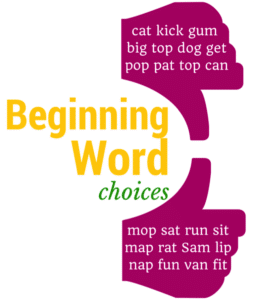
However, after your beginner has developed the ability to Blend As He Reads some of the time, please do begin to include words that do begin with Stop Consonants. Just don’t try to help a student struggling with blending or a beginner with these words.
Tricks of the Trade
(Or, What to Do When Your Student Still Doesn’t Get It)
Modeling the Blend As You Read approach is critical for success. Try this sequence:
- Teacher modeling
- Student copying
- Repeat
- Drop the Teacher Modeling
- Student tries on his own
If you try to drop the Teacher Modeling, but your student looks up at you with the deer in the headlights look, don’t panic! And don’t quit!
Many young kids hit a roadblock here because the concept of individual sounds stuck together to make a word has never occurred to them. Or, other kids are simply less developed in their phonemic awareness or phonemic processing (perception and processing of individual sound-based info).
Here are 3 tricks that usually help a child leap over this developmental challenge:
- First, ensure that all multi-sensory cues are being demonstrated by you and practiced by him. In other words, align visual and auditory cues, especially.Are you pointing carefully to each sound as you speak teach precise sound? A pencil can more precisely indicate each letter-sound as compared to a finger. Or, a small card can reveal exactly one sound at a time—as you are speaking that precise sound. This process is implicitly revealing the alphabetic principle (that letters are symbols that represent sounds in words) to your student every time you practice it.Similarly for the child, is he really looking at the word? Watch his eyes. Make sure your student is connecting his eyes to the print exactly as he says each sound. And make sure he is stretching out the sounds in each word. You may even ask your student to hum the vowel so it gets emphasis. And for the fun of it!
- Write 2, 3, or 4 similar words on a board or paper. Ask your child to select a word you call out from among this selection. For example,
map mop sop mom
Which one of these is “mop?”
This is a multiple-choice way of reducing the challenge to the task. Only use as long as necessary. Every day you should try to see if your student is ready for independence on this strategy of Blending As You Read.
- Draw 3 simple images on a board or paper. Then write a word that is represented by one of these images on the board/paper. Perhaps you tell your student what each image represents.“This is a sun. This is to sit. This is a snake.”
Then ask your student to
“Look at the word and put the sounds together to figure out what this word is.”
Be sure to cover the “t” with your small card, so he simply sees “si” first.
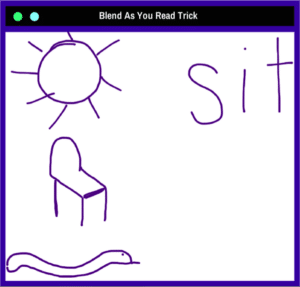
Notice how weak my illustration skills are. You can do at least as good as this, I’m sure!! 😉
The main point is, “Can my student blend sounds left to right on his own to identify an unknown word?” With one or more of these tricks, your student should be able to break through the Blend As You Read sound barrier in a couple of days—2 weeks max.
Summary
After she has mastered the early stages of Blending As You Read, guide your young learner up the phonemic difficulty continuum (see image above). Maria, with her tutor’s help, has moved from CVC words (i.e., “hat”) to CVCC words (i.e., “send”).
Like Maria’s tutor, you will guide your student further and further into an understanding of our written language with this one simple tool in your box. Blending As You Read works for the early reader and will last a lifetime.
What other strategy does a reader need in her decoding toolbox? She should be encouraged to make good use of context as she tries to decode. This happens naturally for almost all children when the Blend As You Read technique is used with the Meaning-Making emphasis as described above.
And later you can teach her another helpful strategy—Flex It—so she can attack unfamiliar vowel sounds to hear an identifiable word. Beyond these 2 strategies (Blend As You Read and Flex It), your young reader needs lots of reading and writing practice to be able to memorize letter-sounds and high frequency words. However, these skills are not strategies=series of steps to accomplish a task. These are simply information to learn.
So, our blog title tease was really quite true—Blending As You Read may be just about the only decoding strategy that your students will need.
Have you tried Blending As You Read? Did you encounter any obstacles? Please comment below to continue the conversation.

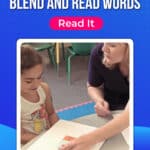
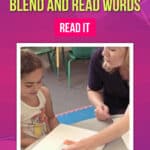
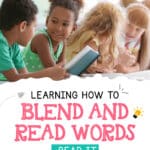

Simply a fabulous article with real applicable information. Thank you for something that isn’t just theory, but with applications that make this doable.
So glad to hear that you find it useful, Barbara! Thanks for letting us know!
I love this strategy and the detailed way in which you presented it! My grandson will be entering kindergarten next year and is reading a little, but this is a great toolbox item. I still wish that kindergarten wasn’t so high pressure!
Thanks for the encouraging feedback, Retta! Yes, if your grandson can Blend As He Reads 3- and later 4-sound words with short vowels, he will be GOLDEN for K. Then I don’t think at least he’ll find it high pressure either.
But I know what you mean–K these days isn’t like the half-day playdates I had myself as a 5 year-old at Humpty Dumpty kindergarten. 😉
This is a terrific article that would be great for student teachers and novice teachers to read. Lots of details and very specific instructions. I love the videos for modeling!
Thanks much for the encouraging words, Kelly.
Yes, I can still recall the frustration I felt when I had a student who couldn’t blend sounds and I had no idea how to help him. Blend As You Read is such a simple strategy but isn’t always intuitive….for the teacher or the student.
This is terrific! I have had my students blending this way for awhile. I noticed that they could blend much more easily than teaching the initial sound plus word family. I am glad to see the research behind it and the detailed plans to accompany this strategy. Thank you!
Carol, it’s great to hear from your experience about this Blend As You Read approach working better!
One teacher I worked with was trying the initial sound plus word family with a struggling K student and the child kept saying “at” for….EVERYTHING, regardless of the short vowel in the word. The teacher then taught her Blend As You Read and did the Switch It activity (readingsimplified.com/integrate-dont-isolate) and the student broke through the barrier. Finally worked up to a 1st grade reading level in a couple of months.
A large minority of children need the explicitness of being taught to hear and manipulate each, individual phoneme which doesn’t happen often in the context of word family instruction. Thanks again for your feedback!
Wow, Thank you for providing such a detailed description of the blend as you read approach. I am teaching my 5-year-old to read and although I have read a lot about phonic awareness, etc, I have not heard about the blend as you read approach before. I will be trying it out with my daughter today. She knows her letter sounds but the words can still be difficult for her to put together. Now I know this could be because we are saying each sound separately. I look forward to learning more from you. Thankyou! 🙂
Excellent timing, then, Kimya! Thanks for letting me know. If her phonemic awareness isn’t super sharp yet, she may also benefit from the Switch It game, which I describe and include a video here: https://readingsimplified.com/integrate-dont-isolate/ (It also builds letter sound knowledge rapidly.)
I hope you are enjoying teaching your daughter!
By any chance do you have any trainings aviable? El Paso Texas
Juron, thanks for asking! Yes, we offer in-person trainings and we will also be opening the Reading Simplified Academy this month.
The Reading Simplified Academy will be an online professional learning membership site where teachers collaborate to learn:
–a handful of Word Work activities that accelerate all learners,
–how to diagnose and plan for efficient instruction,
–juggle a diverse classroom for literacy without working all night :o, and
–how other teachers are streamlining their literacy instruction (via discussion boards).
If you’re not already on our email list, Juron, please consider that so you won’t miss the opening price for the Reading Simplified Academy. If you provide your name and email for the free offers on the bottom of this page or at the top right, you’ll be all set!
Thanks again!
Simply brilliant!
I am moving to preprimary this year after teaching Year 3 so this is the strategy I will be teaching. So simple and explained really wel.
Thanks so much!
Tracy, thanks very much for the lovely praise! Very encouraging. 🙂
Hope the transition to preprimary is smooth and fun. Another great activity for preprimary that I can recommend is Switch It. Learn more about it here: Switch It post.
Years ago ( maybe 40 or so) I played a reading game with my students that was very successful. It was called “Game of Transformation”, my students called it the transformer game. Students were given a word to start with and then encouraged to change one letter at a time to make a real word that they could read–the game often went on “forever”. Students could play individually or in a group or with the whole class. Does this game sound familiar to you? I think I learned it while teaching Words in Color. I enjoyed your article and found a lot of your ideas to be very solid.
Shari, thanks so much for the kind words and for sharing the game. I haven’t heard of it! But I love to learn more about reading approaches, so I’ll check it out…Definitely sounds high in engagement!
Thank you for this! I can’t wait to try it on my kids.
This was really good!! I loved it. It makes so much sense with the kindergarteners.
Great Karen! One can accelerate kinders so much with these activities. Thanks for giving them a go!
Such an excellent article on blending. Thank you for the clear explanation through text and in video. You have helped me to understand why children make certain errors and how to offer them ways in which to be guided towards using blending when reading words that they might struggle with.
Thanks very much, Heather! I’m so glad we got connected! Please keep me informed of what successes and challenges you have…
Very informative! Can’t wait to use these strategies with my kiddos!
Thanks for the reading strategies can’t wait to use them on my students in September, 2018.
This is a fabulous resource which I would love to share with my parents and followers – except I can’t promote the sound based decoding coupled with the meaning making – because it promotes guessing. My understanding is that research has cleared demonstrated that the eyes of good readers ‘touch’ every letter in words and their brains are automatically and unconsciously mapping sounds to spellings, i.e. our brains track through the whole word, without our conscious awareness of the process. It looks like we are recognising whole words, only because a complete process has unfolded behind our awareness. Which is why good readers will ‘register’ when they have incorrectly read a word. Their brains are tracking through the whole word and will alert them to the ‘guess’. A good reader knows that and goes back to the word to reread it. All these younger students need to develop the habit of tracking left to right through words decoding (and encoding). Otherwise what might look like reading acquisition unravels down the track and the guessing habit has to be slayed. I also suspect meaning making needs an entire discussion on its own. Meaning can only be made if a child possesses the language to interpret. Is meaning making an assessment of a child’s language acquisition? A great resource and I like the addition of the use of the card to support working memory. I will give that a try with my younger students.
Georgina, thanks for your thoughtful comments! I agree wholeheartedly that guessing is a scourge to young readers. 😉
I’m NOT proposing guessing here. Instead, I’m proposing that we cultivate the natural meaning-making process inside of all humans…as the reader tries to attack unknown words.
I would like you to consider the difference between the young student who is learning to read and the mature reader who has already acquired automaticity with the code. Your description of how good readers read reflects a different level of competence than the level of beginning or struggling readers.
The student with developing sound-based decoding skills does not and cannot yet recognize by sight all the letter combinations and high frequency words that an experienced reader recognizes. Thus, as our intrepid young reader approaches an unknown word, s/he should use his/her developing sound-based decoding skills to attack the word. AND, at the same time, we want to encourage her to connect that sound-based system (the phonological) with meaning (the semantic system). That’s how she knows she’s come up with a reasonable attempt. The word makes sense!
These connections among visual, phonological, and semantic are how science has been describing the processing of reading and learning to read for a few decades now. See Seidenberg’s Language at the Speed of Sight or David Share’s Self-Teaching Hypothesis paper for different takes on this dynamic of connections across different brain domains.
Some phonics programs are so focused on teaching the code that they forget that the process of reading is not just de-coding alone. It’s the simultaneous processing of meaning with sound and print. So amazing really! At Reading Simplified, we aim to give students the necessary sound-based decoding tools to attack unknown words as they integrate that information with their semantic side.
In the end, I wonder if your doubts about what I’m saying are because “meaning-making” has been a term controlled by whole language advocates. In this context, however, I’m suggesting that the child has the capacity–the brilliant capacity–to link the meanings of specific words in her oral vocabulary with the sound-symbol associations she’s seeing on the page. Hope this clarifies!
This was such an informative article. My school is closed for a few more weeks, so I can’t use this with my students. I may have to do some teaching with my grandchildren.
Thank you so much, Hilda. I do hope it helps move the needle with your students AND grandbabies! 🙂
Is there a point that you encourage readers to blend in their head, rather than out loud?
Neat question, Mel! Usually, this happens naturally when children have developed sufficient mastery of the blending skill. So, most of the time, I don’t explicitly coach them to blend silently because they adopt the habit in good time.
If you have a particular student in mind with a blending issue, I’d be happy to think on this further with you….
I look forward to trialing this decoding strategy with my ‘severely dyslexic’ 8 year old grandchild. Thank you again Marnie for such an informative presentation. You adroitly explain the subtleties of our language with such clarity even as a non-language specialist teacher like me who was expected to teach everything anyway to understand!
Sian, thank you so much for the encouraging words. Just so pleased that you used the word “adroidtly!” 😉
Another core strategy I suggest you try is Switch It; it pairs perfectly with the activity you just read about, Read It: ReadingSimplified.com/integrate-dont-isolate
This blog has been a great reminder for me as an experienced teacher who now tutors. I have an older reader who needs to be rewound to blend as she reads so that she can tackle the more difficult texts she is coming across rather than sounding word by word. Thanks for inspiring our next lesson.
I think this information would be perfect for graduate teachers. It is easy to follow. Thank you
Thank you so much for your kind words, Rae! So glad this has served your readers well.
Marnie,
How are the silent e words addressed?
We begin that when we begin Sort It. See more here.
This information is wonderful and so important- thank you for the many examples and the explanations about why it is so important. I was wondering if you have any research or suggestions for children learning to read in more than one language, and would it be safe to say many of the same principles apply (specifically for Spanish immersion students that are non native Spanish Speakers).?
Hi Nancy! I DO believe these strategies work with any alphabetic language based on theories and research of reading development. However, I haven’t implemented them in another language myself. We do have a few French immersion teachers inside our Reading Simplified Academy who are testing them out. So far it seems positive.
I would test out Switch It first, to see if you can adapt that: ReadingSimplified.com/integrate-dont-isolate
Can you do Switch It with whiteboards (erasing the letter that needs to be changed) or should it always be done with letter cards?
Yes, Connie, absolutely. We often move there as soon as the foundational letter-sounds skills are intact so we can save time and the hassle of the cards.
I love this article! I have been doing something similar with my students and have noticed a big difference in how they blend sounds together.
In your article, you mention matching the level of phonemic difficulty in the words a teacher chooses to instruct to the child’s current ability level. Do you have an assessment that a teacher can do with their students to determine what level they are at (cvc, cvcc, ccvc, ccvcc, cccvc, ms)?
Thank you for your guidance. I look forward to hearing from you.
Thanks April! Yes, we have an informal snapshot assessment here:
https://readingsimplified.com/reading-levels-assessments/
Thanks for the helpful tips on improving children’s reading!
Do you have any recommendations for doing this exercise with students online?
Hi Sue! You can create Google or PowerPoint slides with the words you want for Read It (one word per slide), and cover parts of the words with a colored text box that you can slide over as students blend as they read. If you want to manipulate the text box slider, simply share the screen, one slide at a time. If you share the link for Google slides, students can manipulate the text box slider if they have been given “editor” permission.
After the student has read the word, they can write the word on their own whiteboard, saying the sounds as they write, and hold their whiteboard up for you to see. Or , if it works, tilt the screen so you can observe their writing. When finished, erase the sounds as they say them.
Here are some video examples and premade resource options.
https://www.youtube.com/watch?v=8S8DXftBpHA&ab_channel=EmilyLaidlaw
https://www.youtube.com/watch?v=wO3HKvw95Xg&ab_channel=EmilyLaidlaw
I appreciate the authenticity and vulnerability you bring to your writing.
Thank you Ilan!
It’s so impactful and great thanks
May it serve your readers well!
I have used this blending strategy with my students in intervention for a few years, but I still have kids who struggle to use the correct short vowel sounds thus blending the word incorrectly. Maybe we are not teaching the vowels correctly in our district? What is your approach and tips for teaching the short vowel sounds?
We do pair this Blend AS You Read strategy in Read It with Switch It.
Switch does a lot of compare/contrast work which really builds short vowel knowledge. Check it out here:
Readingsimplified.com/integrate-dont-isolate